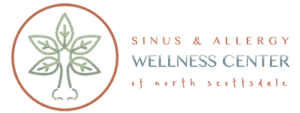Allergic Rhinitis: 6 Herbal Remedies to Try | Sinus & Allergy Wellness Clinic

Home > Blog > Allergic Rhinitis: 6 Herbal Remedies to Try | Sinus & Allergy Wellness Clinic
Allergic Rhinitis: 6 Herbal Remedies to Try | Sinus & Allergy Wellness Clinic
6 Herbal Remedies for Allergic Rhinitis
We get a lot of questions from patients inquiring about ideas of natural solutions for treating their allergy symptoms. We are devoting this blog to explaining two common types of allergies we most often see at our office in Arizona and share some natural herbal which may help.
Please keep in mind, that we are not giving medical advice in this blog. We cannot properly treat your unique condition or allergy without seeing you or conducting one of our comprehensive allergy tests. We suggest you talk to your doctor.
What is Allergic Rhinitis
Allergic rhinitis is an inflammatory condition that affects the nasal passages, sinuses, ears, and throat. Also known as pollinosis and hay fever, it occurs when an allergic person inhales an allergen to which they are sensitive.
There are two types of allergic rhinitis. Seasonal allergy sufferers develop symptoms during spring, fall, or both seasons when they become exposed to airborne pollen and outdoor mold spores. Perennial allergic rhinitis, which is year-around, is caused by indoor allergens such as house dust, pet dander, dust mites, and indoor molds.
Symptoms:
The symptoms of this allergy include itching, sneezing, runny nose, postnasal drip, as well as congestion of the nose, ears, and sinuses. There could also be fatigue and a general feeling of being "unwell" during an allergy attack. These symptoms vary in severity from person to person.
Herbal Treatment Options for Allergies
Herbal remedies could provide an alternative way to treat allergic rhinitis. If used sensibly, these natural medicines can not only reduce allergic symptoms but also prevent them altogether. They can also strengthen the body's tissues and organs, thus improving your overall health. Here are some of the herbs best suited for treating allergies and various respiratory issues.
- Stinging Nettle (Urtica dioica)
This plant is well-known to those unfortunate enough to accidentally brush against its leaves. Stinging nettle might be a painful encounter for many an aspiring gardener; nevertheless, it is one of the most effective herbal treatments for allergic rhinitis. As an antioxidant, astringent, antimicrobial, and analgesic, it can reduce allergy-related inflammation without producing any of the side-effects that come with the use of pharmaceuticals. Fresh nettle is available in spring. Cooking the leaves will remove their stinging effects, and you can add them to your salads, soups, or stews, like most other green leafy vegetables. You can also use it in its dried form to brew nettle tea.
- Perilla (Perilla frutescens)
This somewhat obscure herb is a member of the mint family, and it can help you with the battle against your allergic rhinitis symptoms. Many studies have shown perilla to be useful for the treatment of nasal congestion, sinusitis, allergic asthma, and eye irritation (another trouble for many allergy sufferers). It can also alleviate allergic-related skin conditions. It is worth mentioning that the essential oils found in perilla have an antidepressant effect and boost serotonin levels in the brain. In other words, this amazing herb not only reduces inflammation in the body, but it also improves your mood and increases your feeling of well-being.
- Sea Buckthorn (Hippophae rhamnoides)
This plant grows into a shrub or small tree, easily recognized by its thorny, grey twigs and bright orange ovoid fruit. Sea buckthorn contains more than 190 nutrients and phytonutrients. This extremely nutrient-dense berry offers an array of organic acids, tannins, quercetin, provitamin A, vitamin E, and a great deal of vitamin C, as well as B complex vitamins. What's more, it contains copious amounts of superoxide dismutase (SOD), an enzyme that plays a critical part in maintaining respiratory health. Sea buckthorn is ideal for people who suffer from allergic rhinitis, as well as asthma, chronic coughs, and other breathing disorders. Its unique nutrient content improves the health of eyes, mouth, and mucous membranes. There are numerous sea buckthorn products on the market today; you should choose carefully, however, and always buy from a reputable company with high standards for quality.
- Butterbur (Petasites hybridus)
The butterbur shrub grows in the marshes of North America, Europe, and Asia. People have used it traditionally for the treatment of pain, headaches, fevers, and digestive ailments. More recently, it has also been used for urinary tract infections, headaches, including migraines, as well as for the treatment of hay fever. Butterbur has also been the object of scientific study with promising results. One such study found that this herb works similarly to Zyrtex, a prescription allergy medication. Butterbur products contain extracts from the root, rhizome, or leaves. You should not use this herb in its raw form since it contains certain alkaloids (PAs) that are harmful to humans. Always opt for products labeled as PA-free.
- Ginger (Zingiber officinale)
Ginger is a safe and highly effective herb. Apart from its culinary uses, it is very beneficial to your overall health, since it soothes the digestive system and improves circulation. Ginger works as a natural antihistamine, potent antiviral agent, and immune booster. Try some ginger tea to alleviate nasal congestion and headaches. While you sip your tea, inhale the steam coming out of your cup. You can find ginger commercially in fresh and dried form. You can also pair it with other herbs, such as turmeric, which is another powerful natural healer.
- Yarrow (Achillea millefolium)
Yarrow is a perennial herb native to the British Isles, but also common throughout Europe and Asia. This multi-purpose herb has antiseptic, stomachic, antispasmodic, astringent, and diaphoretic properties. Used traditionally to treat colds, the flu, and fevers, yarrow can also be a useful remedy against allergic rhinitis. Its anti-microbial and anti-catarrhal actions make it an ideal herb for the respiratory system, and this natural healer also treats sinusitis and dust allergies. You can take yarrow in tea form or as a tincture. This is a potent herb and internal daily use is not recommended beyond the limit of two consecutive weeks. Furthermore, you should avoid this herb if you are allergic to ragweed, as these two plants are related.
Natural Plants can be Effective Medicine:
Herbal remedies can offer relief from the symptoms of allergic rhinitis, as well as other respiratory issues. If used sensibly and proactively, they can also boost your immune system and prevent the onset of the allergic reaction. However, before trying any new treatment, it is essential that you consult a specialist.
While they may have fewer side effects than conventional medications, herbs are medicine too (albeit natural), and you should treat them as such. Be mindful of the proper dosage as well as contraindications, and please see your allergy specialist or doctor before taking.
If you are interested in getting help for your specific allergy, please contact us by phone at 480-767-7098 to schedule an in-person appointment for allergy testing and consultation with one of our top-rated sinus and allergy doctors at our North Scottsdale Sinus and Allergy clinic.
Sources
"Ginger." Rodale's Illustrated Encyclopedia of Herbs. Edited by Claire Kowalchik and William H. Hylton, Rodale Press, 1987, p. 223.
Lipkowitz, Myron A., and Tova Narava. The Encyclopedia of Allergies. Facts on File, Inc., 2001 (second edition), pp. 13-14.
Schapowol A. and Petasites Study Group, "Randomised Control Trial of Butterbur and Cetirizine for Treating Seasonal Allergic Rhinitis," BMJ Vol. 324, no. 7330, 2002, pp. 144-46.
Schoffro Cook, Michelle. Allergy-Proof Your Life: Natural Remedies for Allergies That Work!, Humanix Books, 2017.
"Sea buckthorn". The Illustrated Encyclopedia of Herbs: Their Medicinal and Culinary Uses. Edited by Sarah Bunney, Dorset, 1984, p. 166.
Disclaimer:
The information provided in this article is for informational and educational purposes only and does not constitute medical advice. It is not intended to diagnose, treat, cure, or prevent any disease or medical condition. Always seek the guidance of your physician or other qualified healthcare provider with any questions you may have regarding a medical condition or treatment.
Results may vary: Treatment outcomes and health experiences may differ based on individual medical history, condition severity, and response to care.
Emergency Notice: If you are experiencing a medical emergency, call 911 or seek immediate medical attention.



